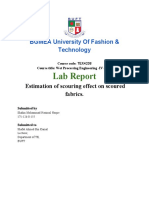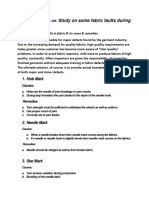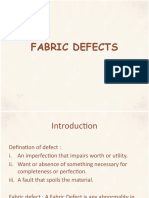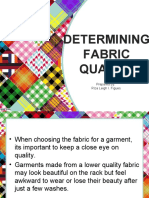0 ratings0% found this document useful (0 votes)
174 viewsFlammability Testing of Fabrics by Govardhana Rao Chilukoti
Flammability Testing of Fabrics by Govardhana Rao Chilukoti
Uploaded by
Venkatesh BairabathinaThis document discusses key terms and issues related to testing the flammability of fabrics. It outlines several applications where defining a fabric's flammability behavior is important for safety, including furnishings, transport, construction, medical, and defense. The document defines terms used in flammability testing such as ignition, flaming, glowing, smoldering, melting, flame spread time, flaming debris, surface flash, and afterglow time. It also mentions two common flammability tests - the simple ignition test and the flame spread test.
Copyright:
© All Rights Reserved
Available Formats
Download as PPTX, PDF, TXT or read online from Scribd
Flammability Testing of Fabrics by Govardhana Rao Chilukoti
Flammability Testing of Fabrics by Govardhana Rao Chilukoti
Uploaded by
Venkatesh Bairabathina0 ratings0% found this document useful (0 votes)
174 views14 pagesThis document discusses key terms and issues related to testing the flammability of fabrics. It outlines several applications where defining a fabric's flammability behavior is important for safety, including furnishings, transport, construction, medical, and defense. The document defines terms used in flammability testing such as ignition, flaming, glowing, smoldering, melting, flame spread time, flaming debris, surface flash, and afterglow time. It also mentions two common flammability tests - the simple ignition test and the flame spread test.
Original Description:
Flammability Testing of Fabrics
Copyright
© © All Rights Reserved
Available Formats
PPTX, PDF, TXT or read online from Scribd
Share this document
Did you find this document useful?
Is this content inappropriate?
This document discusses key terms and issues related to testing the flammability of fabrics. It outlines several applications where defining a fabric's flammability behavior is important for safety, including furnishings, transport, construction, medical, and defense. The document defines terms used in flammability testing such as ignition, flaming, glowing, smoldering, melting, flame spread time, flaming debris, surface flash, and afterglow time. It also mentions two common flammability tests - the simple ignition test and the flame spread test.
Copyright:
© All Rights Reserved
Available Formats
Download as PPTX, PDF, TXT or read online from Scribd
Download as pptx, pdf, or txt
0 ratings0% found this document useful (0 votes)
174 views14 pagesFlammability Testing of Fabrics by Govardhana Rao Chilukoti
Flammability Testing of Fabrics by Govardhana Rao Chilukoti
Uploaded by
Venkatesh BairabathinaThis document discusses key terms and issues related to testing the flammability of fabrics. It outlines several applications where defining a fabric's flammability behavior is important for safety, including furnishings, transport, construction, medical, and defense. The document defines terms used in flammability testing such as ignition, flaming, glowing, smoldering, melting, flame spread time, flaming debris, surface flash, and afterglow time. It also mentions two common flammability tests - the simple ignition test and the flame spread test.
Copyright:
© All Rights Reserved
Available Formats
Download as PPTX, PDF, TXT or read online from Scribd
Download as pptx, pdf, or txt
You are on page 1of 14
Flammability testing of
fabrics
Govardhana Rao Chilukoti
Assistant Professor
VFSTR Deemed to be University
• Apart from apparel clothing, the need for
textiles requiring defined flammability
behaviour for improved safety spans a range
of applications that includes:
– furnishing and bedding (domestic and contract)
– Transport
– civil engineering,
– medical and
– defence
Key issues of fabric flammability
Terms used
• Ignition: Flaming of the test specimen for a
period of 1s or more after removal of the igniting
flame.
• Flaming: Combustion in gaseous phase with
emission of light
• Glowing: Combustion of a material in the solid
phase without flame but emission of light from
the combustion zone.
• Smouldering: combustion of a material with or
without emission of light generally evidence
by smoke.
• Melting: Liquefaction of material when
exposed to heat to the extent of forming a
hole in its structure, by either shrinking and/or
dripping away under the specified test
conditions.
• Flame spread time: the time taken by a flame
on a burning material to travel a specified
distance measured from when the igniting
flame is applied or after it has been remove.
• Flaming debris: materials separating from the
specimen during the test procedure and
falling below the initial lower edge of the
specimen and continuing to flame as they fall.
• Surface flash: rapid spread of flame over the
surface of a material without ignition of its
basic structure.
• Afterglow time: the time for which a material
continues to glow, under specified test
condition, after cessation of flaming or after
removal of the ignition source, ignoring
glowing debris.
Simple ignition test
Flame spread test
You might also like
- Modern Cotton Spinning Machinery, Its Principles and ConstructionFrom EverandModern Cotton Spinning Machinery, Its Principles and ConstructionNo ratings yet
- Estimation of Scouring Effect On Scoured Fabrics.Document3 pagesEstimation of Scouring Effect On Scoured Fabrics.nasimul haqueNo ratings yet
- Testing For Knitted FabricDocument11 pagesTesting For Knitted FabricRAVIKANT DEONo ratings yet
- Thermasol Dyeing Method of Polyester FabricDocument1 pageThermasol Dyeing Method of Polyester FabricrashidtexNo ratings yet
- Colour Matching TriangleDocument3 pagesColour Matching TriangleArun KumarNo ratings yet
- Textile Testing: Presented By: Nisha Sangle Ankita Desai Poonam Patil Gayathri RangnathanDocument23 pagesTextile Testing: Presented By: Nisha Sangle Ankita Desai Poonam Patil Gayathri RangnathanChaaya AaldarNo ratings yet
- List of DefectsDocument5 pagesList of DefectsIRFANA ASLAM100% (2)
- Color FastnessDocument68 pagesColor FastnessSaurabh Singh Rajput100% (5)
- Quality Testing of The Terry Towel and Its Assurance MsDocument6 pagesQuality Testing of The Terry Towel and Its Assurance MsPankaj vermaNo ratings yet
- Textile Testing: MFM Semester-II Sudeshna Datta RoyDocument54 pagesTextile Testing: MFM Semester-II Sudeshna Datta RoyPriyanka Narain BanoriyaNo ratings yet
- Exercise No: AIM Appartus: Chemicals: EquipmentDocument2 pagesExercise No: AIM Appartus: Chemicals: EquipmentjayantNo ratings yet
- Continuous Dyeing MachineDocument18 pagesContinuous Dyeing Machinebigstar42100% (1)
- Human Comfort: Evaluating Comfort and Related Physical Properties of TextilesDocument37 pagesHuman Comfort: Evaluating Comfort and Related Physical Properties of Textilesne_mohtashim100% (1)
- MercerisationDocument18 pagesMercerisationVarun Mehrotra0% (1)
- Textile Finishing - Textile CentreDocument17 pagesTextile Finishing - Textile CentreashrafbookNo ratings yet
- Textile Dyeing - Introduction-LibreDocument10 pagesTextile Dyeing - Introduction-LibreGanga Dharan100% (1)
- To Determine The Color Fastness To Perspiration: Submitted byDocument5 pagesTo Determine The Color Fastness To Perspiration: Submitted bymuhammad-ahsin-mughal-237No ratings yet
- Colour FastnessDocument23 pagesColour FastnessShalini Yadav100% (1)
- Dyeing FaultsDocument10 pagesDyeing FaultsMehedi Hassan EvanNo ratings yet
- National Textile University Faculty of Engineering & TechnologyDocument11 pagesNational Textile University Faculty of Engineering & TechnologyShahan Akhtar100% (1)
- Green University of Bangladesh: Department of Textile EngineeringDocument9 pagesGreen University of Bangladesh: Department of Textile EngineeringGreen University TextileNo ratings yet
- Commonly Used Finishing Methods On FabricsDocument4 pagesCommonly Used Finishing Methods On FabricsRajesh Dwivedi100% (1)
- DewateringDocument3 pagesDewateringnahidulbutex002No ratings yet
- Thesis Presentation of Wet Processing Group 8Document37 pagesThesis Presentation of Wet Processing Group 8Nirnoy ChowdhuryNo ratings yet
- 36 Finishing Parameters and Controlling FactorsDocument48 pages36 Finishing Parameters and Controlling FactorsApar Singh100% (1)
- Shade Variation in DyingDocument22 pagesShade Variation in DyingRishi KumarNo ratings yet
- Textile Lab Report TitleDocument3 pagesTextile Lab Report TitlezubairNo ratings yet
- SanforisingDocument17 pagesSanforisingUjwala JainNo ratings yet
- Mechanical Finishing: Presented by Nikhil PatilDocument31 pagesMechanical Finishing: Presented by Nikhil PatilJaishuNo ratings yet
- Final Mill Tariniggng ReportDocument53 pagesFinal Mill Tariniggng ReportPriyanka VishnoiNo ratings yet
- Stone WashDocument3 pagesStone WashMuhammad MustahsinNo ratings yet
- Final PPT - LeninDocument34 pagesFinal PPT - LeninAman AnshuNo ratings yet
- Textile Testing & Quality: Title: Martyndale Pilling Testing MethodDocument6 pagesTextile Testing & Quality: Title: Martyndale Pilling Testing MethodTauqeer RazaNo ratings yet
- Heat B SettingDocument18 pagesHeat B SettingharisNo ratings yet
- Assignment Base On: Study On Some Fabric Faults During Processing.Document5 pagesAssignment Base On: Study On Some Fabric Faults During Processing.MD Nazrul IslamNo ratings yet
- Wool 482 582 12 T 14 PDFDocument22 pagesWool 482 582 12 T 14 PDFRahman Trading CorporationNo ratings yet
- Woven Fabric Defects and InspectionDocument37 pagesWoven Fabric Defects and InspectionShresha DasNo ratings yet
- Objectives of Textile TestingDocument28 pagesObjectives of Textile TestingShruthiNo ratings yet
- 191003060-Lab Report 5Document6 pages191003060-Lab Report 5Tanzila NusratNo ratings yet
- Mechanical FinishingDocument43 pagesMechanical FinishingUjwala Jain100% (1)
- Presentation On Mercerization ParametersDocument40 pagesPresentation On Mercerization ParametersSaif Rahman100% (1)
- Final Assignment: Textile Testing & Quality Control-IIDocument11 pagesFinal Assignment: Textile Testing & Quality Control-IINoman ahmedNo ratings yet
- SpandexDocument1 pageSpandexNavnath PingaleNo ratings yet
- Working With Data Color (Raj Rahad) Southeast UniversityDocument13 pagesWorking With Data Color (Raj Rahad) Southeast UniversityRaj RahadNo ratings yet
- Textile Finishing 1Document40 pagesTextile Finishing 1Mujahid MehdiNo ratings yet
- Determining Fabric Quality: Prepared By: Riza Leigh I. FiguesDocument55 pagesDetermining Fabric Quality: Prepared By: Riza Leigh I. FiguesRizaLeighFigues100% (1)
- On Textile TestingDocument17 pagesOn Textile TestingGourav Arora100% (2)
- Tinting or OverdyeingDocument4 pagesTinting or OverdyeingDelwar Hossain67% (3)
- Introduction of Dyeing PDFDocument13 pagesIntroduction of Dyeing PDFImran100% (1)
- Textile Dyeing and Printing: AssignmentDocument8 pagesTextile Dyeing and Printing: AssignmentshailajaNo ratings yet
- WPT 2Document141 pagesWPT 2SalimNo ratings yet
- Slasher Sizing Machine - Main Parts of Slasher Sizing Machine - Textile LearnerDocument3 pagesSlasher Sizing Machine - Main Parts of Slasher Sizing Machine - Textile LearnerTholkappiyan Ganesan100% (1)
- Textile Testing & Quality ControlDocument12 pagesTextile Testing & Quality ControlAshikur Rahman100% (1)
- CompactorDocument4 pagesCompactornahidulbutex002No ratings yet
- Development of Jute / Cotton Blended Garment For Winter Wear By: B. Sathish BabuDocument31 pagesDevelopment of Jute / Cotton Blended Garment For Winter Wear By: B. Sathish BabuAjaz Banna100% (1)
- AATCC - 89 - Mercerization in CottonDocument2 pagesAATCC - 89 - Mercerization in CottonNguyễn Công Thoại100% (1)
- DenimsDocument40 pagesDenimsJyoti RawalNo ratings yet
- Dyeing and Printing DefectsDocument35 pagesDyeing and Printing DefectsGemeda GebinoNo ratings yet
- Textile Printing (Methods of Printing) : Lecture# 4-6Document35 pagesTextile Printing (Methods of Printing) : Lecture# 4-6Mujahid MehdiNo ratings yet
- Tensile Strength Measurement Principles:: CRL, Cre & CRTDocument7 pagesTensile Strength Measurement Principles:: CRL, Cre & CRTVenkatesh Bairabathina100% (3)
- Measurement of HumidityDocument19 pagesMeasurement of HumidityVenkatesh Bairabathina50% (2)
- Tensile Strength Measurement Principles:: CRL, Cre & CRTDocument7 pagesTensile Strength Measurement Principles:: CRL, Cre & CRTVenkatesh Bairabathina100% (3)
- Factors Affecting The Regain of Textile FiberDocument8 pagesFactors Affecting The Regain of Textile FiberVenkatesh BairabathinaNo ratings yet
- Fiber Investigation Techniques: B. Venkatesh Asst - Professor Dept. of Textile Fashion Tech VFSTR UniversityDocument26 pagesFiber Investigation Techniques: B. Venkatesh Asst - Professor Dept. of Textile Fashion Tech VFSTR UniversityVenkatesh BairabathinaNo ratings yet
- Fiber Structure TheoriesDocument16 pagesFiber Structure TheoriesVenkatesh Bairabathina100% (1)
- Clothing ComfortDocument14 pagesClothing ComfortVenkatesh BairabathinaNo ratings yet
- Venkatesh. B Asst. Prof Textile TechnologyDocument14 pagesVenkatesh. B Asst. Prof Textile TechnologyVenkatesh BairabathinaNo ratings yet
- Need and Selection of ClothingDocument15 pagesNeed and Selection of ClothingVenkatesh BairabathinaNo ratings yet
- Fibre ScienceDocument38 pagesFibre ScienceVenkatesh Bairabathina100% (1)
- Drawing & Texturising ProcessDocument56 pagesDrawing & Texturising ProcessVenkatesh Bairabathina100% (1)
- Product Development GarmentsDocument7 pagesProduct Development GarmentsVenkatesh Bairabathina100% (1)
- Auxilliary MechanismsDocument20 pagesAuxilliary MechanismsVenkatesh BairabathinaNo ratings yet







































































